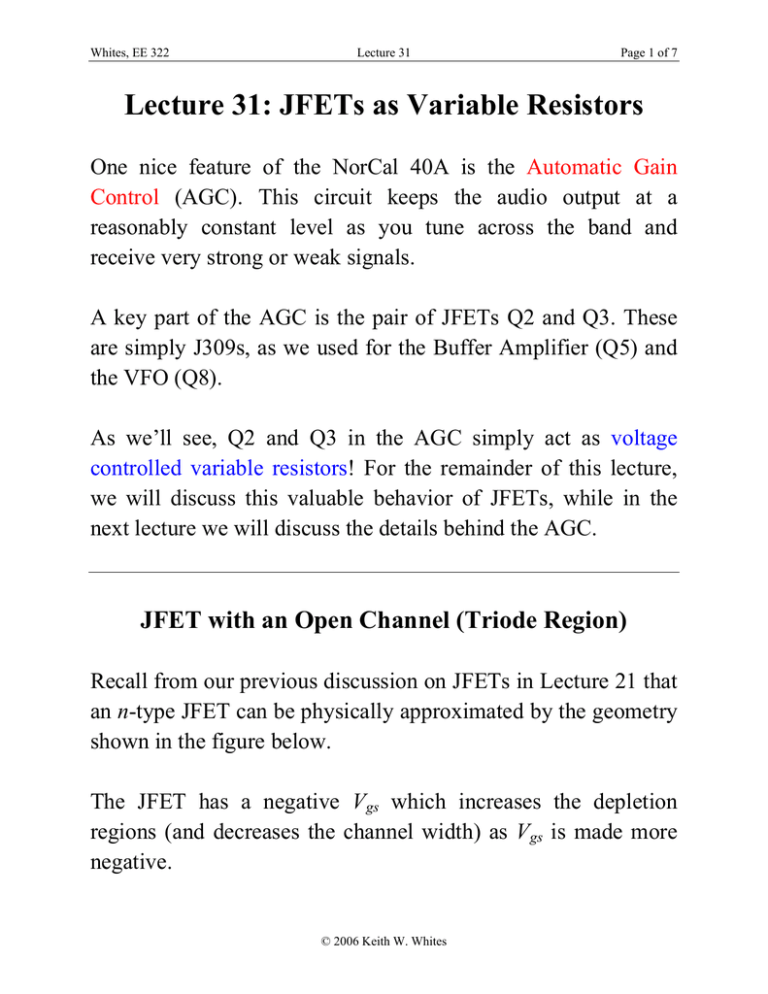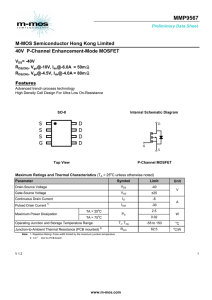Lecture 31: JFETs as Variable Resistors
advertisement

Whites, EE 322 Lecture 31 Page 1 of 7 Lecture 31: JFETs as Variable Resistors One nice feature of the NorCal 40A is the Automatic Gain Control (AGC). This circuit keeps the audio output at a reasonably constant level as you tune across the band and receive very strong or weak signals. A key part of the AGC is the pair of JFETs Q2 and Q3. These are simply J309s, as we used for the Buffer Amplifier (Q5) and the VFO (Q8). As we’ll see, Q2 and Q3 in the AGC simply act as voltage controlled variable resistors! For the remainder of this lecture, we will discuss this valuable behavior of JFETs, while in the next lecture we will discuss the details behind the AGC. JFET with an Open Channel (Triode Region) Recall from our previous discussion on JFETs in Lecture 21 that an n-type JFET can be physically approximated by the geometry shown in the figure below. The JFET has a negative Vgs which increases the depletion regions (and decreases the channel width) as Vgs is made more negative. © 2006 Keith W. Whites Whites, EE 322 Lecture 31 Page 2 of 7 D Depletion regions Ids G p p G Vds (small) n Vgs S Current Ids will flow from drain to source. The amount of current (at a given Vds) depends on the channel resistance, rds. As Vgs becomes more negative, the depletion regions grow wider and the channel narrows. Consequently, the channel resistance rds increases. Assuming Vds is small enough, this behavior can be represented by straight lines of varying slope in a characteristic plot of the JFET transistor: Id Vgs=0 Vgs=-1 Vgs=-2 Vgs=Vc Vds (small) As Vgs becomes more negative, eventually the two depletion regions combine and the channel is depleted of all charge carriers (e- for n channel) and no current will flow. This Whites, EE 322 Lecture 31 Page 3 of 7 particular Vgs is the JFET pinch off (or cut off) voltage Vc. It is a negative number for n-channel JFETs. We can view this effect in a JFET as a voltage controlled resistance (VCR). Saturated JFETs For completeness, we’ll quickly mention what happens to the channel as Vds becomes large, though this is not the regime in which Q2 and Q3 operate in the NorCal 40A. As Vds increases, Vgs remains constant while the reverse bias “voltage” of each pn junction will increase as we move up the channel. This will give a tapered shape to the depletion region: D n E G E p p G Vds Vgs Ids S The channel becomes pinched off at the drain end when Vgd = Vc Whites, EE 322 Lecture 31 Page 4 of 7 However, current still flows in the channel because charge carriers can drift through this relatively small depletion region. Note that this “pinch off” is not the same as the JFET being completely pinched off so that no current can flow. Here, pinch off is occurring only at the drain end of the device. Also, notice that as Vds increases from this pinched off state, there will be little change in Id! The maximum Id occurs when Vgs = 0 and is defined as Idss, the drain-to-source current with the gate shorted. As Vgs (< 0) varies, a larger region of the channel becomes depleted. This implies rds increases, which implies a smaller Id. From this behavior, we can generate a family of characteristic curves as shown in Fig. 13.4: When the JFET is biased with a “large” Vds and Vc < Vgs < 0 , it will operate in the so-called active (or saturation) region. Whites, EE 322 Lecture 31 Page 5 of 7 Linear or Triode Region of the JFET In the JFET linear region (also called the triode region or VCR region), the drain current is expressed as ⎛ 2 I dss ⎞ ⎛ V ⎞ I d = Vds ⎜ 2 ⎟ ⎜ Vgs − Vc − ds ⎟ [A] (13.12) 2 V ⎠ ⎝ c ⎠⎝ For small Vds [ 2 (Vgs − Vc ) ], as is the case in the linear region, ⎛ 2I ⎞ I d ≈ Vds ⎜ dss V − Vc ) [A] (1) 2 ⎟ ( gs ⎝ Vc ⎠ By definition, the channel resistance rds is computed as V rds = ds [Ω] I d V small (2) ds Using (1) in (2) we find for small Vds that −1 ⎡ I ⎤ 1 rds ≈ ⎢ 2 dss2 (Vgs − Vc ) ⎥ = [Ω] N ⎣ Vc ⎦ ( )G Plots of these two quantities in (3) are shown in Fig. 13.5: 13.13 (3) Whites, EE 322 Lecture 31 Page 6 of 7 JFETs in the AGC So how are the JFETs applied as variable controlled resistors in the NorCal 40A? Fig. 13.9 shows them as the AGC attenuators: More specifically, consider the Q2 circuit connected to U3: C20 charges to VC20 < ≈ Vs through Q2 and the internal 50-kΩ resistor at pin 2 of U3. Vd will be slightly less than Vs because of Whites, EE 322 Lecture 31 Page 7 of 7 the Q2 channel resistance. Because of this Vds is small, which implies Q2 operates in the triode region. The VCR control voltage is Vgs. Here is an equivalent model for this Q2 circuit: A similar model applies to the Q3 circuit. We’ll see in the next lecture that the AGC will vary rds in response to the output voltage at the speaker.



